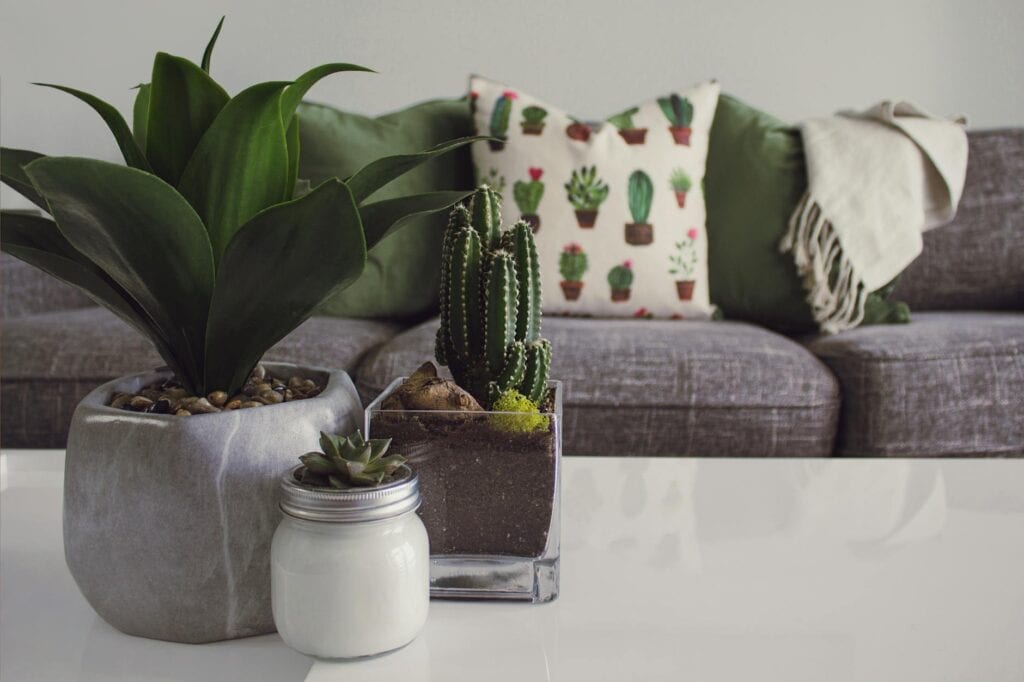Decorating your home with indoor plant decor isn’t just about adding greenery—it’s about bringing life, beauty, and tranquillity into your living space. Whether you live in a cozy apartment in New York City or a spacious house in the English countryside, indoor plant decor can completely transform your environment. In this guide, we’ll explore the ins and outs of using indoor plants to elevate your home, focusing on the practicalities, aesthetics, and benefits of indoor plant decor. By the end of this post, you’ll be equipped with the knowledge to turn your home into a lush, green sanctuary.

The Allure of Indoor Plants
Indoor plant decor has taken the interior design world by storm, and for good reason. Plants are versatile, they can fit any style—from minimalist to bohemian—and they bring a piece of nature into your home. But beyond aesthetics, indoor plants offer numerous benefits:
- Improved Air Quality: Plants like snake plants, spider plants, and peace lilies filter toxins from the air, making your home healthier.
- Enhanced Mood: The presence of greenery has been shown to reduce stress, increase productivity, and promote relaxation.
- Natural Humidifiers: Plants release moisture, which can help keep your home’s humidity at a comfortable level, especially during dry winters.
Choosing the Right Plants for Your Indoor Plant Decor
Assessing Your Environment
Before you start adding indoor plants to your home, it’s crucial to consider the specific conditions of your living space. Here are some factors to keep in mind:
- Light Availability: How much natural light does your space receive? Some plants thrive in bright, direct sunlight, while others prefer low light.
- Space Constraints: Do you have ample floor space, or do you need to think vertically with hanging plants or wall-mounted planters?
- Climate Control: Consider the temperature and humidity levels in your home. Some plants are more resilient to fluctuations, while others need a stable environment.
Popular Indoor Plants for Every Room
Now that you’ve assessed your space, it’s time to choose the right indoor plants. Here are some recommendations based on different areas of your home:
- Living Room: Fiddle leaf figs, rubber plants, and monstera are statement pieces that thrive in well-lit living rooms.
- Bedroom: Snake plants and peace lilies are perfect for bedrooms due to their air-purifying properties and low light tolerance.
- Bathroom: Ferns, orchids, and pothos love the humidity of bathrooms and add a spa-like feel.
- Kitchen: Herbs like basil, mint, and rosemary not only look great but are also practical for cooking.
Why These Choices Matter
Choosing the right indoor plants for the right environment ensures they thrive, adding to the decor’s longevity and the health benefits they provide. This thoughtful approach underlines the “Why” in the Golden Cycle—your indoor plant decor choices should reflect the specific conditions and needs of your home.
- Designing with Plants: Aesthetic Principles
Creating Focal Points
One of the most effective ways to use indoor plants in decor is by creating focal points. These are areas that draw the eye and make a statement. Here’s how you can do it:
- Feature Plant: Choose a large, visually striking plant like a fiddle leaf fig or a tall cactus to anchor your living room.
- Plant Groupings: Cluster smaller indoor plants together on a shelf or side table to create a lush, layered effect.
- Hanging Gardens: Use macramé hangers or wall-mounted planters to add vertical interest.
Balancing Greenery with Other Decor Elements
While indoor plants can be the star of your decor, it’s important to balance them with other elements:
- Texture and Color: Pair indoor plants with materials like wood, metal, or ceramics to create contrast and interest. Consider the color of your pots as well—they can either blend in or stand out.
- Space and Flow: Make sure your indoor plant decor enhances the flow of the room. Avoid overcrowding areas and allow enough space for your plants to grow.
The Impact on Mood and Atmosphere
The right indoor plant decor doesn’t just look good—it feels good. Indoor plants can create a calming, welcoming atmosphere, making your home a place of refuge and relaxation. This aspect ties back to the “Why” in the Golden Cycle—understanding the emotional and psychological impact of your indoor plant decor choices.
- Caring for Your Indoor Plants: Practical Tips
Watering Basics
One of the most common mistakes in indoor plant care is improper watering. Here’s how to get it right:
- Know Your Plant’s Needs: Some indoor plants like to dry out between waterings (e.g., succulents), while others like consistent moisture (e.g., ferns).
- Check the Soil: Before watering, check the top inch of the soil. If it’s dry, it’s time to water. If it’s still moist, wait a few days.
- Watering Techniques: Use a watering can with a long spout to reach the base of the plant. Avoid getting the leaves wet, as this can lead to mould and mildew.
Lighting Considerations
Light is crucial for indoor plant health. Here’s how to ensure your indoor plants get the right amount:
- Direct Sunlight: Plants like cacti and succulents need direct sunlight for several hours a day. Place them in south-facing windows.
- Indirect Light: Most indoor plants, like pothos and philodendrons, prefer bright, indirect light. A spot near a window but out of direct sunlight is ideal.
- Low Light: For spaces with limited light, choose indoor plants like snake plants or ZZ plants, which can tolerate low light conditions.
Feeding and Fertilizing
Plants need nutrients to thrive. Here’s what you need to know about feeding your indoor plants:
- Type of Fertilizer: Use a balanced, water-soluble fertilizer for most indoor plants. For flowering plants, choose a fertilizer with a higher phosphorus content.
- Frequency: During the growing season (spring and summer), feed your indoor plants once a month. In fall and winter, reduce feeding to every two to three months.
- Signs of Nutrient Deficiency: Yellowing leaves, stunted growth, and lack of blooms can indicate a need for fertilizer.
Pest Control
Indoor plants can sometimes fall prey to pests like spider mites, aphids, and fungus gnats. Here’s how to keep them at bay:
- Regular Inspection: Check your indoor plants regularly for signs of pests, such as discolored leaves, sticky residue, or visible insects.
- Natural Remedies: For minor infestations, use a solution of water and dish soap to wipe down the leaves. Neem oil is also effective against a wide range of pests.
- Prevention: Keep your indoor plants healthy with proper care, as healthy plants are less susceptible to pests. Quarantine new plants before introducing them to your collection to prevent the spread of pests.
Why Care is Key
Taking care of your indoor plants ensures they stay healthy and vibrant, which in turn keeps your decor looking fresh and beautiful. This attention to care connects back to the “Why” in the Golden Cycle—healthy indoor plants not only enhance your home’s appearance but also contribute to a healthier, happier living environment.
- Seasonal Indoor Plant Decor: Adapting to Changes
Winter and Indoor Plants
Winter can be a challenging time for indoor plants due to reduced light and lower humidity. Here’s how to help your indoor plants thrive during the colder months:
- Maximize Light: Move indoor plants closer to windows to capture as much natural light as possible. You can also supplement with grow lights.
- Maintain Humidity: Use a humidifier to combat dry indoor air, or place a tray of water near your indoor plants to increase humidity.
- Reduce Watering: Plants grow more slowly in winter, so reduce watering frequency to avoid root rot.
Spring and Summer: Growth Seasons
Spring and summer are when your indoor plants will thrive and grow the most. Here’s how to support their growth:
- Increase Watering: As your indoor plants enter their active growth phase, they’ll need more water. Be sure to adjust your watering schedule accordingly.
- Repotting: Spring is the ideal time to repot your indoor plants if they’ve outgrown their current containers. Choose a pot that’s one size larger and use fresh potting mix.
- Pruning: Trim back any dead or overgrown foliage to encourage new growth and maintain the shape of your indoor plants.
Seasonal Decor Ideas
As the seasons change, you can update your indoor plant decor to reflect the time of year:
- Fall: Incorporate warm-toned planters and add dried flowers or branches to your indoor plant arrangements for a cozy, autumnal feel.
- Holiday Season: Dress up your indoor plants with festive ornaments, lights, or ribbons for a holiday-themed decor.
- Spring: Add fresh flowers alongside your indoor plants to celebrate the season of renewal and growth.
Adapting to Seasonal Changes
Understanding how to care for and decorate with indoor plants seasonally ensures that your indoor plant decor remains vibrant and relevant year-round. This adaptability reinforces the “Why” in the Golden Cycle—by aligning your decor with the seasons, you create a dynamic, living space that evolves throughout the year.
Conclusion: Creating Your Own Indoor Plant Haven
Bringing It All Together
Decorating with indoor plants is more than just a trend—it’s a way to bring nature into your home, enhance your well-being, and express your style. By understanding the appeal of indoor plant decor, choosing the right plants for your space, designing with aesthetics in mind, and providing the care your plants need, you can create a home that’s not only beautiful but also a sanctuary of peace and health.
Your Next Steps
Ready to transform your home with indoor plant decor? Start by assessing your space and choosing plants that suit your environment and style. As you incorporate these green companions into your decor, don’t forget to consider the care and seasonal changes that will keep them thriving. Your home is a reflection of your personality—let your indoor plants be a vibrant, living part of that expression.
By following this guide, you’ll be able to confidently use indoor plant decor to create a stunning and serene home environment. Whether you’re a seasoned plant parent or a beginner looking to add a touch of green to your space, the tips and ideas here will help you make the most of your indoor plants. Happy decorating!
